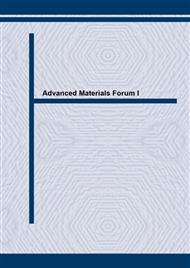[1]
H. L. Hartnagel, A. L. Dawar, A. K. Jain, G. Jagdish, Semiconducting, Transparent Thin Film, IOP Publishing, Bristol and Philadelphia, 1995.
Google Scholar
[2]
H. K. Pulker, Coatings on Glass, 2nd ed., Elsevier (1999)
Google Scholar
[3]
C. Goebbert, H. Bisht, N. Al-Dahoudi, R. Nonninger, M. A. Aegerter, H. Schmidt, Sol-Gel Science and Technology, 19, 201-204, 2000.
DOI: 10.1023/a:1008728103512
Google Scholar
[4]
N. Al-Dahoudi, M. A. Aegerter, in: Proc. of the Sixth International Conference on Frontiers of Polymers and Advanced Materials ICFPAM, Recife/Brazil, 4-9 March, 2001.
Google Scholar
[5]
C. Goebbert, R. Nonninger, M. A. Aegerter, H. Schmidt, Thin Solid Film, 351, 79 - 84 (1999). Fig. 5 Surface morphology of 350 x 260 Im size MPTS/ITO antiglare coating (Zygo Newview) on a PC substrate. The average roughness is Ra = 140 nm. Fig. 6 Glaze of a white object placed in front of a AS-AG coated plastic (left) and an uncoated one (right). The picture of the building placed 2 cm behind the substrates is clearly visible in both configurations.
DOI: 10.1016/s0040-6090(99)00209-6
Google Scholar


